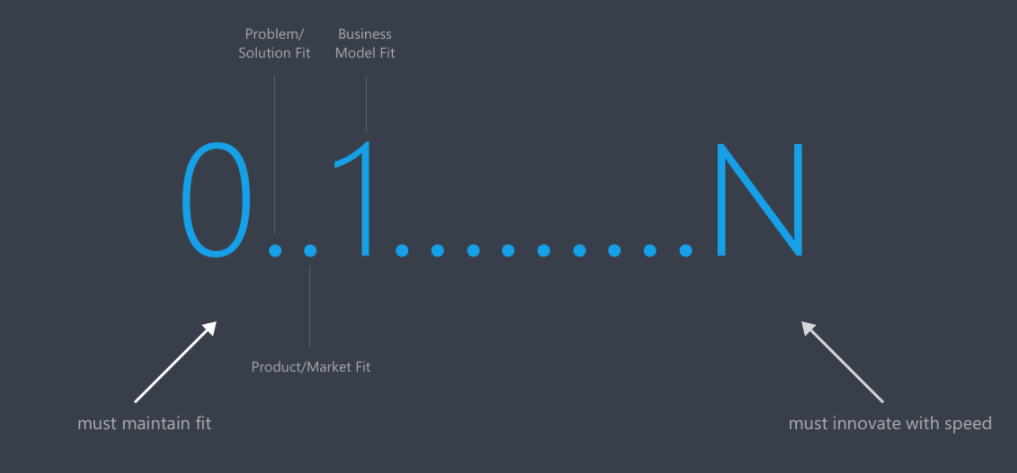Beyond Product/Market Fit, Three Types Of Fit
Sep‑2017
You’ve probably heard about Product/Market fit. In case you haven’t, here’s the Marc Andreessen quote that popularized the term:
“You can always feel when product/market fit isn’t happening. The customers aren’t quite getting value out of the product, word of mouth isn’t spreading, usage isn’t growing that fast, press reviews are kind of ‘blah’, the sales cycle takes too long, and lots of deals never close. And you can always feel product/market fit when it’s happening. The customers are buying the product just as fast as you can make it — or usage is growing just as fast as you can add more servers. Money from customers is piling up in your company checking account. You’re hiring sales and customer support staff as fast as you can. Reporters are calling because they’ve heard about your hot new thing and they want to talk to you about it. You start getting entrepreneur of the year awards from Harvard Business School. Investment bankers are staking out your house. You could eat free for a year at Buck’s.” Marc Andreessen
It’s an important concept but in this post I wanted to talk about product/market fit in the context of fit that precede and follow it: problem/solution fit and business model fit.
From an idea to a business to a startup
To turn an idea into a successful business or to borrow Peter Thiel’s terminology, to go from 0 to 1, you need to take your product through three essential stages, not necessarily in this order:
- Problem/Solution fit
- is this a really important problem for customers you test with
- do all of the target customers you test with consistently and repeatedly walk away highly satisfied with your solution
- Product/Market fit
- can you get the value proposition you create in the hands of your market
- can you develop a relationship with a large enough portion of your market to get quality feedback and iterate on your product
- does the market stay highly satisfied with your solution over a mid to long period of time
- is the size of the market considerable enough to project a high return on investment
- can you easily expand your product to further satisfy the market’s adjacent needs OR adjacent users with similar needs
- Business model fit
- are customers willing to pay more money than it costs you to build and maintain the product
- does the life time value of each customer greatly out weigh the cost of acquisition + cost of goods
By definition, a startup is able to do all three while strategically focused on scalability:
- Saturate your current market until all customers are highly satisfied
- Expand your product to further satisfy the market’s adjacent needs OR adjacent users with similar needs
- Repeat to N
This is also known as taking a business from 1 to N, N being markets permeable by a similar or slightly modified product as the one you currently have. A lot of large companies have products in this stage, e.g. LinkedIn, Outlook, Facebook. Scaling is about finding the lowest common denominator of needs your product can satisfy for as many markets as possible. The smaller the change needed to satisfy a new market, the more cost efficient it is to scale.

Working on fit
Naturally, the majority of product work revolves around figuring out how to establish and improve fit. Here I wanted to share a couple of lessons I’ve learned.
Problem/Solution fit rarely equals Product/Market fit
Problem/solution fit is a product/market fit hypothesis. It is not however equal to product/market fit. This is an important distinction to make.
Let’s say we have absolutely no quantitative data to support a hypothesis we may have about a problem in the real world. We are going to refine our understanding by talking to some hypothesized target users in order to solve this problem. What we could do is find 10 hypothesized target users and ask them questions about the problem. We could then come up with a hypothesized list of solutions to test with them. After trimming the list and finding what seems to be working we would drill into it. Perhaps we would find readability issues or usability issues. We’d go through and fix those.
Assuming we’re able to get through these steps successfully, we would reach a point where everyone is happy and says they would use our solution at home. Hooray, we’ve achieved Problem/Solution fit! Our small sample of participants is now highly satisfied with the proposed solution.

Statistically, there is nothing that guarantees that those 10 people are representative of who we think our target users are though. Going back to the checklist above, we need to walk through the steps in Product/Market fit. Can I reach the right people for this solution? Is this an important problem for enough people? Is someone already doing this much better? In the long term, would people find it valuable enough to continue using? There is a slew of questions to answer before being able to establish Product/Market fit. Again, Problem/Solution fit is really just your and those 10 people’s hypothesis of what the market might like. Testing the solution with the market is a separate step.

Example: Getting fit
When we started working on Leanrr.com we had a simple vision. We imagined a world where everybody is healthy and beautiful. By talking to about 100 people we found some of the biggest problems were around misinformation, getting started, and sustainability. We recruited a few colleagues and friends to embark on a weight loss journey with us. After a lot of iteration and failure we found the critical steps to success:
- A granular and monthly feedback loop.
- You can track weight loss by using the scale but water weight and how much you ate that morning drastically affect your measurement. We discovered a technology called BodPod that allows you to measure body fat progression at a ~0.5% granularity. We then started doing monthly check ins to see exactly how we were progressing.
- Delicious and easy to make foods.
- Everyone is busy, everyone likes tasty food. We found it was critical to have food that people can really enjoy yet not be bogged down cooking.
- A sustainable mentality.
- By putting the focus on progress (from #1) instead of being “perfect” we developed a necessary mental shift. This had a big effect because most people coming in had a “all or nothing” mentality where’s realistically failing for a day or a week doesn’t make a big difference in a 2-4 month journey.
I was able to go from 15% to 8% body fat in 3 months myself. It was easy and felt incredible! We wanted to get the word out.
Unfortunately, product/market fit was an entirely different story. We had 500,000 target users view our ads and 5.6% click through to the landing page. 20% of those who clicked signed up but only 0.1% of them got their BodPod measurement! We were hit with the market reality. The lesson for us was to simultaneously search for a market while continually making the solution simpler. Even if you have a great solution it still takes a lot of work to get to a point where you’re able to get the right people interested and invested.
Measuring whether you’ve improved Product/Market fit
Another important topic is how to measure whether you’ve improved product/market fit.
For large products where there are several markets and value propositions you can perform Market tests using A/B testing. By focusing on metrics that are representative of the user problem you are trying to fix, you can see if for the majority of users the change was a positive addition. The key thing is looking at your product as a system when evaluating these changes. Don’t just measure how you’ve changed the particular user experience but see how you affect the feature and value proposition involved. (More about Market/Product pyramid here.)
Conventionally, in Outlook it usually takes us 3-5 A/B tests before we’re able to establish whether a feature improved product/market fit. The steps we tend to go through and measure:
- Can the right people discover and remember the feature?
- Does the language used convey value appropriately?
- Are people able to complete the task 1 time?
- Is the task easy enough to use repeatedly?
- Is it valuable?
If you are a smaller product you can’t use A/B testing. That’s because you don’t have a significant portion of your market captured nor do you have a statistically significant amount of usage. What you would want to observe is how the new user cohort retention reacts to changes. This works quite well in practice because the market and value propositions of the product are simple and you should have a good idea about what caused an improvement or a dip. You can still do this for bigger products but in conjunction with A/B tests to discern what is causing the effects and for whom.
Business model fit
I’ve never directly worked on business model fit so I don’t have any learning to share. I’ll update this part when I do. 🙂